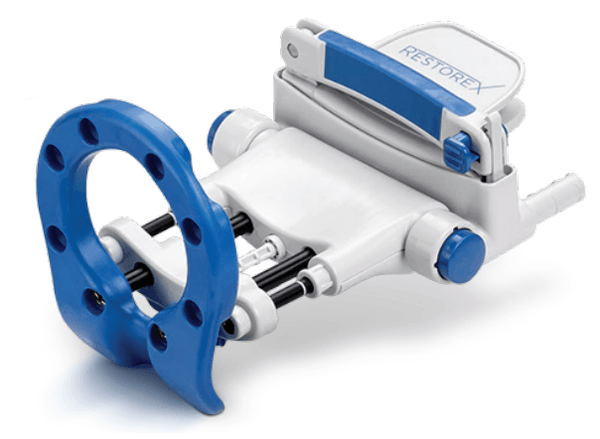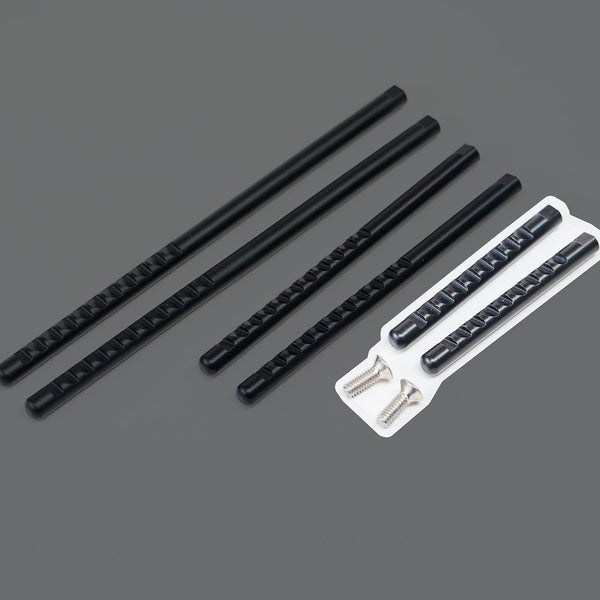Discover our clinical studies and their summaries to confirm the effectiveness of RestoreX™.
Study No. 1A | Study No. 2A | Study No. 3A | Study No. 4A | Study No. 5A |


J. Joseph & al.: Outcomes of RestoreX™ Penile Traction Therapy in Men with Peyronie's Disease: Results from Open Label and Follow-up Phases / The Journal of Sexual Medicine – 2020; 17:2462-2471
Clinical evaluation of penile traction therapy with RestoreX™ in men with Peyronie's disease: Results of the open phase and follow-up phase.
Jason Joseph, Matthew J Ziegelmann, Manaf Alom, Joshua Savage, Tobias S Köhler, Landon Trost
Summary of the study
CONTEXT
A randomized, controlled clinical study evaluating the efficacy of therapy
Penile traction with RestoreX™ in men with Peyronie's disease (PD) has been completed and 3-month results have been previously reported.
This study presents
the results of the open access and follow-up phases of the initial trial.
METHOD
A randomized, controlled clinical study was conducted from 2017 to 2019 on 110 men with Peyronie's disease.
Men were randomized in a 3:1 ratio to the RestoreX™ (PTT) group and the no-treatment (control) group for 3 months, followed by open-access and 3-month follow-up phases.
Primary endpoints included adverse events (AEs), changes in penile curvature and length, erectile function, and standardized and nonstandardized assessments of Peyronie's disease.
RESULTS
Primary endpoints include safety, penile length, penile curvature, Peyronie's disease questionnaire, International Index of Erectile Function, and satisfaction.
At 6 months (n = 64) and 9 months (n = 63), results were reported, with a mean duration of penile traction therapy (PTT) use of 31.1 minutes.
No significant adverse events were reported, with temporary redness and discomfort being the most common symptoms and resolving within minutes.
In the intention-to-treat analysis, men in the control to PTT groups experienced significant improvements in length (1.7-2.0 cm) and curvature (18-20%).
Men in the PTT group also gained additional length (0.6-0.8 cm) without further improvement in curvature.
An analysis based on PTT use for ≥15 minutes per day showed length gains of 2.0–2.3 cm (the largest to date) and an improvement in curvature of 18–21%.
All domains of sexual function of the International Index of Erectile Function and the Peyronie's Disease Questionnaire were significantly improved (except the orgasmic domain).
95% of men treated for 6 months saw length gains (mean 2.0–2.2 cm), and 61% saw improvements in curvature (16.8–21.4° [32.8–35.8%]).
RestoreX™ was preferred 3-4 times more often than all other Peyronie's disease treatments, and 100% of men preferred it over other PTT devices.
CLINICAL IMPLICATIONS
Daily use of RestoreX™ for 30 minutes results in significant improvements in length and curvature in men with Peyronie's disease, without significant adverse events.
STRENGTHS AND LIMITATIONS
Strengths of this study include the largest randomized study of penile traction therapy (PTT), blinded assessments, and inclusion of all participants with few restrictions.
Limitations include sample size, which precludes comparisons between treatment groups, and the lack of a long-duration treatment arm (>3-9 hours).
CONCLUSION
Penile traction therapy (PTT) with RestoreX™ results in significant improvements in length, curvature, and subjective and objective measures of sexual function without significant adverse events. RestoreX™ PTT represents a safe, conservative, and inexpensive option for the management of men with Peyronie's disease.
MJ Ziegelmann & al.: Outcomes of a Novel Penile Traction Device in Men with Peyronie's Disease: A Randomized, Single-Blind, Controlled Trial / AUA - The Journal of Urology – September 2019, Volume 202, Page:599-610
Results of a novel penile traction device in men with Peyronie's disease.
Matthew Ziegelmann, Josh Savage, Amir Toussi, Manaf Alom, David Yang, Tobias Kohler and Landon Trost.
Summary of the study
OBJECTIVE
Current penile traction therapy devices have significant limitations, including the need to use them for 3 to 8 hours per day.
In response to these issues, the new RestoreX™ penile traction therapy device was developed in collaboration with the Mayo Clinic.
MATERIALS AND METHODS
We conducted a randomized, controlled, single-blind, intention-to-treat study (ClinicalTrials.gov NCT03389854) in men with Peyronie's disease who were assigned to use the penile traction therapy device for 30 to 90 minutes per day, or no therapy for 3 months.
Study inclusion criteria were a curve of 30 degrees or greater, with no study exclusion due to complex curves, hourglass deformity, previous treatments or surgeries for Peyronie's disease, or calcifications.
The primary endpoint was safety, and secondary endpoints were penile length and curvature, and responses to questionnaires.
RESULTS
A total of 110 men were randomly assigned in a ratio of 3 to the penile traction therapy group or the control group.
The cohorts were well matched, with a mean age of 58.4 years, a history of Peyronie's disease of 49.7 months, and a mean curvature of 59.3 degrees.
Overall, penile traction therapy was well tolerated, with only transient and mild adverse events reported.
At 3 months, men undergoing penile traction therapy showed significant improvements compared with the control group in penile length (1.5 vs. 0 cm, p < 0.001), curvature (11.7 vs. 1.3 degrees, p < 0.01), and erectile function (4.3 vs. -0.7, p < 0.01) according to the International Index of Erectile Function among Men with Erectile Dysfunction.
Overall, 77% of men undergoing penile traction therapy experienced an improvement in curvature (average of -17.2 degrees in 28.2% of respondents), while 94% experienced a gain in length (1.6 cm in 10.9%).
Reverse flexion and the white line indicator improved the efficiency, validating the main innovations of the device.
Among men who had previously used other penile traction therapy devices, 100% preferred the RestoreX™ device.
CONCLUSION
Penile traction therapy with the RestoreX™ device for 30 to 90 minutes daily has been shown to be safe and to result in significant and clinically meaningful improvements in penile curvature and length in men with Peyronie's disease, and in erectile function in men with erectile dysfunction and Peyronie's disease, without any significant adverse events.
To our knowledge, these data represent the only improvements reported for a device used less than 3 to 8 hours per day.
K. Wymer et al.: Comparative Cost-effectiveness of Surgery, Collagenase Clostridium Histolyticum, and PenileTraction Therapy in Men with Peyronie's Disease in an Era of Effective Clinical Treatment / The Journal of SexualMedecine - 2019;16:1421e1432
Comparative cost-effectiveness of surgery, collagenase Clostridium histolyticum, and penile traction therapy in men with Peyronie's disease in an era of effective clinical treatment.
Kevin Wymer, MD, Tobias Kohler, MD, and Landon Trost, MD
Summary of the study
CONTEXT
Traditionally, surgery has been considered the gold standard treatment for Peyronie's disease (PD).
Less invasive alternatives, such as collagenase Clostridium histolyticum (CCH) and traction therapy, have been proposed and proven effective.
OBJECTIVE
To compare the cost-effectiveness of management options for Peyronie's disease (PD).
METHODS
A Markov analytical model was created to compare the cost-effectiveness of treatment with a novel traction device, RestoreX™ (RXPTT), versus CCH and surgery.
Results were obtained from prospective data from a single institution, including 63 men treated with RXPTT, 115 with CCH, and 23 with a fold or incision and graft.
Costs were based on 2017 Medicare reimbursements and utility values from the literature.
KEY OUTCOME MEASURES
Model results included complications for each treatment option, as well as the probability of success, defined as a 20% improvement in curvature.
Univariate and multivariate sensitivity analyses were performed to test the robustness of the model.
RESULTS
The overall success rates were 96% (surgery), 66% (CCH), and 48% (RXPTT).
After 10 years of treatment, RXPTT was the most cost-effective, with mean costs per patient of $883 (RXPTT), $11,419 (surgery), and $33,628 (CCH).
Both CCH and surgery resulted in a gain in quality-adjusted life years (QALYs) compared with RXPTT (9.44 and 9.36 vs. 9.27, respectively).
Sensitivity analysis showed greater cost-effectiveness for surgery with lower rates (less than 46%) of postoperative erectile dysfunction or length loss (less than 3%).
CCH became more cost-effective at lower costs ($16,726) or higher success rates (greater than 76%).
Multivariable sensitivity analysis, with a willingness-to-pay threshold of $100,000 per QALY, showed that the most cost-effective strategy was RXPTT in 49% of simulations, surgery in 48%, and CCH in 3%.
At a willingness-to-treat threshold of $150,000 per QALY, the most cost-effective treatment option was RXPTT in 33% of simulations, surgery in 55%, and CCH in 12%.
CLINICAL IMPLICATIONS
In an era of value-based care, this model can guide the selection of cost-effective treatments based on provider, patient, and payer characteristics.
STRENGTHS AND LIMITATIONS
The current study represents the first comparison of the cost-effectiveness of treatment modalities for Peyronie's disease, strengthened by prospective data collection, large CCH and traction samples, and robust sensitivity analyses.
Consistent with economic models, the model is limited by assumptions and may not apply to all situations.
CONCLUSION
RXPTT represents a more cost-effective method of achieving a 20% improvement in curvature compared to surgery or CCH.
Depending on treatment goals, surgical complication rate, and willingness-to-pay threshold, surgery and CCH may become more cost-effective in specific scenarios.
M.J. Ziegelmann & al.: Clinical Experience with Penile Traction Therapy Among Men Undergoing Collagenase Clostridium histolyticum for Peyronie’s Disease / AUA - The Journal of Urology – January 2017104: 108
Évaluation du traitement de la maladie de Lapeyronie avec le Collagénase de Clostridium Histolyticum (CCH) associé à un dispositif de traction-thérapie (Andropenis™).
M. Alom & al.: Efficacy of Combined Collagenase Clostridium histolyticum and RestoreX™ Penile Traction Therapy in Men with Peyronie’s Disease / The Journal of Sexual Medecine - 2019;16:891e900
Évaluation de la sécurité et l'efficacité du RestoreX™ associé à la Collagénase de Clostridium Histolyticum (CCH) par rapport à la CCH seule et à la CCH associée à d'autres dispositifs de traction-thérapie (AndroPenis™, X4 Labs Penis Extender™ et PeniMaster™).
B. Green & al.: Comparison of Collagenase Clostridium histolyticum to Surgery for the Management of Peyronie’s Disease: A Randomized Trial / The Journal of Urology 210(5):p 791-802, November 2023.
Étude clinique prospective et randomisée comparant la thérapie de la maladie de Lapeyronie entre 1 groupe Collagénase de Clostridium Histolyticum + RestoreX™ + Sildenafil (groupe CCH) versus une autre thérapie Chirurgie + RestoreX™ + Sildenafil (groupe chirurgie).


